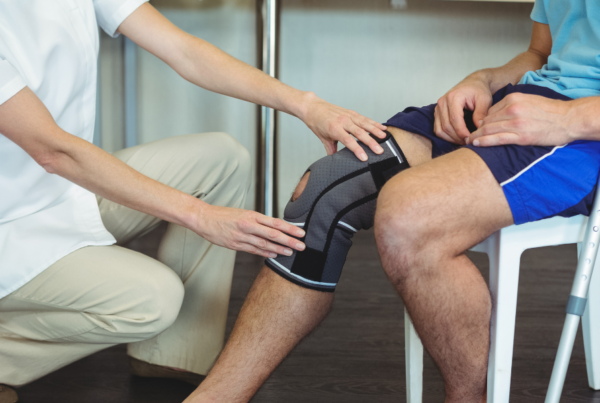Physical Therapy for Cancer Survivors
Move Better. Live Fuller. Your Wellness Journey Starts Here.
Schedule a FREE Discovery Call!
About Cancer Survivorship
Content Warning: This article discusses topics surrounding cancer, cancer treatments, and their effects on the body.
Cancer survivorship describes the period of time following any cancer diagnosis, where specialized care is needed for the diagnosed individual. Survivorship care can vary from person to person, but targets all types of challenges regarding cancer, both physical and emotional.
Individuals who have undergone cancer treatments such as surgery, chemotherapy, hormone therapy, or radiation will need a multidimensional care approach that properly encapsulates all of their needs. This includes managing side effects and symptoms that occur as a result of cancer.

Symptoms and side effects of cancer can vary greatly depending on its type and severity, as well as the treatment methods used to target the cancer. Oftentimes, these aspects can significantly affect the musculoskeletal system, causing changes in posture, movement, joint health, balance, muscle function, or nerve function. Certain types of cancers or treatment can create neurological or vestibular symptoms as well, which involve the musculoskeletal system in many ways.
These side effects may be a direct result of changes or damage to tissue, or as a result of surgeries, radiation, and other forms of treatment. These changes can affect a person’s ability to walk, move efficiently, or perform daily tasks due to side effects such as pain, weakness, mobility impairments, scar tissue, adhesions, or other side effects of conventional treatments. Some common symptoms following cancer diagnosis and treatment include the following:
- Post-surgical pain
- Limited mobility due to surgery, scarring, or inactivity
- Posture changes due to pain
- Muscle imbalances, tightness, or weakness
- Misalignment from postural changes
- Dizziness or problems with balance
- General fatigue
- Nerve pain
- Peripheral neuropathy
- Low spinal mobility or core function
- And more
Not only does this affect a person’s quality of life, but it also impacts their safety. Individuals with weakness, changes in bone density, scar restrictions, and other impairments to mobility become much more prone to falls and fractures. To support a better overall well-being and quality of life alongside cancer treatment, these side effects can be supported by physical therapy.
Orthopedic physical therapy can help address many of these symptoms through a variety of treatments and comprehensive care. This form of care can vary greatly depending on the individual’s needs, but often involve treatments and exercises to restore muscular strength, balance, flexibility, coordination, range of motion, and confidence!
Before we go into more detail about treatment, let’s first look at some examples of cancers that can affect mobility and musculoskeletal function.
How Cancers Affect the Body
Many different cancers and their treatments can have a wide range of effects on the body. These cancers don’t just affect the tissue directly, but can cause body-wide symptoms that affect daily life. Many conventional treatments can affect more than just the targeted tissues as well. Therefore, we’ve outlined several types of cancer and the effects they have below.
Please keep in mind that every person’s experience is very different, and cancer can be unpredictable at times. Some individuals may have a different experience or combination of symptoms during their survivorship journey than what is described below. Additionally, this is not an all-encompassing list of cancers that can affect the body, but simply some common examples.
Neurological Cancers
The brain, spinal cord, and nerves make up the neurological system, which helps the body move and feel sensations. It is very important for aspects such as balance and coordination. Cancers to these parts of the body can have an impact on an individual’s ability to maintain balance, walk, and perform activities. They can often create symptoms such as:
- Dizziness
- Poor coordination
- Muscle weakness
- Problems with balance
- Difficulty walking
- And more
Breast Cancers
Breast cancers can vary widely from person to person. These cancers, as well as their associated treatments and surgeries, can cause a variety of effects such as the following:
- Muscle or joint weakness
- Swelling
- Pain
- Stiffness
- Scar tissue restrictions
- Change in movement patterns
- And more
Abdominal Cancers
Abdominal cancers are those that affect parts of the digestive system, such as the stomach, intestines, rectum, and more. Conventional treatment for these types of cancers can include chemotherapy, radiation, surgeries, and more. These types of cancers and their treatments can create the following effects:
- Weakness and fatigue
- Changes in posture
- Inflexibility
- Difficulties with walking
- Pain
- Swelling
- And more
Bone Cancers
Bone cancers can refer to two different types of cancer: primary bone cancers, which start in the bones (such as sarcomas, described below) or metastasis, which is cancer that begins somewhere else (such as breast, prostate, or lung cancer) and moves into the bones. Cancer that affects the bones can create a wide range of symptoms, such as pain, stiffness, higher risk of fractures, and mobility challenges. Physical therapy can significantly support individuals with these effects by:
- Encouraging better movement and strength through exercise.
- Offering pain-relieving treatments.
- Providing education and advice on utilizing mobility aids.
Sarcomas
Sarcomas are a type of rare cancer that can affect the muscles, bones, tendons, and other soft tissues. These can travel to other areas of the body, and can have varying effects depending on their location. In many cases of sarcoma treatment, physical therapy can play an important role in rehabilitation by restoring range of motion, flexibility, strength, and coordination. Physical therapy treatment can also help address pain and fatigue associated with conventional treatments.
Conventional Cancer Treatments
In general, cancer treatments such as radiation, chemotherapy, and surgeries can have significant effects on mobility. These treatments may involve the removal or weakening of tissues, loss of bone density, and fatigue. Individuals who undergo these treatments or the effects of cancer may also experience pain, stiffness, and scarring that may further inhibit mobility. Physical therapy can play a very important role in supporting cancer survivors by providing treatment that helps to counteract these effects, providing better strength, bone health, muscle function, and energy!
Physical Therapy for Side Effects of Cancer
Physical therapy can play a very important role in maintaining a cancer survivor’s quality of life. It can help restore movement, comfort, function, and confidence through a variety of treatments. Your Hive physical therapist will create an individualized care plan that is unique to your needs and symptoms. To determine this care plan, they’ll first start with a thorough evaluation.
Evaluation and Examination
To begin your evaluation, your provider will want to discuss your medical history, symptoms, and any related details of your survivorship experience if you are comfortable discussing them. It may be necessary for your physical therapist to collaborate with your other medical professionals such as oncologists, mental health professionals, or surgeons in order to better align your physical therapy treatments to other treatments you may receive.
The evaluation portion will also include a physical examination. The physical examination can vary based on your symptoms and needs, but allows your provider to better understand the physical impacts of your experience with cancer or cancer treatment. It will help them create a proper treatment plan for your individual needs!
Rest assured that at Hive, your comfort is our number one priority. Our providers understand that survivorship can be difficult and emotional, and will never push you to share details or undergo treatments that you are uncomfortable with. You are always in control! Your Hive provider will always request consent before treatment or examination, and will work with your comfort level. We want to do our best to support you in the ways we can, which includes setting a comfortable, safe, and welcoming environment for your care experience.
With that being said, let’s talk more about examinations. Examination may include assessing the tone, flexibility, and coordination of your muscles. Your physical therapist will look for mobility restrictions, discomfort, inefficient movement patterns, misalignment, harmful postures, and other physical aspects that may influence your symptoms. They’ll test your range of motion, gait, balance, and movement mechanics, too.
Once your provider has a better understanding of your physical health in terms of mobility, flexibility, and function, they’ll formulate your care plan to better improve upon those aspects. This care plan will look different for everyone, but can include aspects such as the following:
Strengthening
Many individuals will struggle with muscle loss and weakness as a result of their survivorship experience. This can often be caused or further impacted by hormonal changes, surgical interventions, prolonged inactivity, or direct effects of treatments like chemotherapy. To help rebuild energy, movement, and muscle function, your physical therapist can lead you through treatment and exercises to slowly and progressively rebuild your strength and mobility.
Strengthening the body can help improve your stability, support better posture, and allow you to enjoy a variety of activities. Strengthening can also help improve your balance, walking patterns, and ability to do activities such as lifting or climbing. Your physical therapist will curate a strengthening routine for you while taking into account your unique needs and goals.
Exercise Prescription
While strengthening muscles is important, general exercise and stretching is just as important. Being active before, during, and after cancer treatment is very beneficial, as it prevents stiffness and supports better energy, flexibility, and range of motion. Therefore, in addition to strengthening exercises, your physical therapist can help curate a general exercise routine to keep you in shape and feeling great. This treatment is called exercise prescription, as it’s important for you to continue exercising and stretching outside of the clinic, too!
Manual Therapy
Manual therapy is a very useful treatment that is suitable for addressing musculoskeletal symptoms. It is a physical technique that can be performed with the provider’s hands or a variety of tools. Manual therapy techniques can relieve muscle tightness, improve tissue mobility, increase blood flow, and reduce pain. It can even help address adhesions or restrictive scar tissue, both of which impact mobility and contribute to pain.
There are many types of manual therapy, some of which individuals with certain types of cancer may be contraindicated to. Hive’s providers will only perform treatments that are safe for you—they carefully consider your medical history, needs, and treatments received outside of the physical therapy clinic. As mentioned before, they can collaborate with your other health professionals as needed to better align your physical therapy treatment with your unique survivorship experience.
Behavioral Modifications
There are many different daily habits that can put strain on the body and worsen symptoms during survivorship. These habits may simply be things you’re unaware of doing, or can be a result of other cancer treatments. For example, many conventional treatments can make individuals weak, and may even require long periods of inactivity. In other cases, you may unknowingly have inefficient movement mechanics or poor posture.
When weakened muscles try to perform movements or activities with poor form, they are more susceptible to pain or even injury. Therefore, your physical therapist will look to modify or correct a wide variety of behaviors to help prevent pain or the risk of injury.
This can include things such as:
- Teaching ergonomics for sitting, standing, sleeping, or other daily activities.
- Correcting movement mechanics after surgeries or long periods of inactivity.
- Encouraging and correcting proper posture to reduce pain.
- Correcting breathing patterns and teaching breathing techniques for relaxation.
- Learning how to correctly utilize mobility aids.
When combined with strengthening exercises and other treatments, behavioral modifications can create a well-rounded treatment experience to help you feel and move better!
Collaboration
As mentioned before, our physical therapists are always prepared to work with other professionals outside of the clinic in order to better curate your physical therapy treatments. However, because cancer and its related treatments can often affect more than one area of the body, our providers are prepared to collaborate within the clinic, too! Our orthopedic and pelvic floor physical therapists at Hive often collaborate to provide comprehensive and well-rounded care.
If you experience pelvic-floor related symptoms as a result of your cancer survivorship experience, such as bladder, bowel, or sexual dysfunctions, our providers can provide specialized care. Feel free to read our other page about how physical therapy can address cancer-related pelvic symptoms for more information!
As you can see from all the examples listed above, there are many ways that a physical therapist can support your survivorship journey. Through individualized treatment and sincere care, physical therapy can improve your comfort, function, movement, and confidence! When working with Hive Therapy and Wellness, your treatment plan may include any of the above examples, as well as any of the treatments listed below:
- Neuromuscular re-education
- Manual therapy
- Exercise prescription
- Dry needling
- Cupping
- Tissue scraping
- Behavioral modifications
- Therapeutic activities
- Electrical muscle stimulation
- Spinal manipulation
- Therapeutic modalities
- Biofeedback
Content Warning: This article discusses topics surrounding cancer, cancer treatments, and their effects on the body.
Cancer survivorship describes the period of time following any cancer diagnosis, where specialized care is needed for the diagnosed individual.
Survivorship care can vary from person to person, but targets all types of challenges regarding cancer, both physical and emotional.
Individuals who have undergone cancer treatments such as surgery, chemotherapy, hormone therapy, or radiation will need a multidimensional care approach that properly encapsulates all of their needs.
This includes managing side effects and symptoms that occur as a result of cancer.
Symptoms and side effects of cancer can vary greatly depending on its type and severity, as well as the treatment methods used to target the cancer.
Oftentimes, these aspects can significantly affect the musculoskeletal system, causing changes in posture, movement, joint health, balance, muscle function, or nerve function.
Certain types of cancers or treatment can create neurological or vestibular symptoms as well, which involve the musculoskeletal system in many ways.
These side effects may be a direct result of changes or damage to tissue, or as a result of surgeries, radiation, and other forms of treatment.
These changes can affect a person’s ability to walk, move efficiently, or perform daily tasks due to side effects such as pain, weakness, mobility impairments, scar tissue, adhesions, or other side effects of conventional treatments.
Some common symptoms following cancer diagnosis and treatment include the following:
- Post-surgical pain
- Limited mobility due to surgery, scarring, or inactivity
- Posture changes due to pain
- Muscle imbalances, tightness, or weakness
- Misalignment from postural changes
- Dizziness or problems with balance
- General fatigue
- Nerve pain
- Peripheral neuropathy
- Low spinal mobility or core function
- And more
Not only does this affect a person’s quality of life, but it also impacts their safety. Individuals with weakness, changes in bone density, scar restrictions, and other impairments to mobility become much more prone to falls and fractures.
To support a better overall well-being and quality of life alongside cancer treatment, these side effects can be supported by physical therapy.
Orthopedic physical therapy can help address many of these symptoms through a variety of treatments and comprehensive care.
This form of care can vary greatly depending on the individual’s needs, but often involve treatments and exercises to restore muscular strength, balance, flexibility, coordination, range of motion, and confidence!
Before we go into more detail about treatment, let’s first look at some examples of cancers that can affect mobility and musculoskeletal function.
Many different cancers and their treatments can have a wide range of effects on the body. These cancers don’t just affect the tissue directly, but can cause body-wide symptoms that affect daily life.
Many conventional treatments can affect more than just the targeted tissues as well. Therefore, we’ve outlined several types of cancer and the effects they have below.
Please keep in mind that every person’s experience is very different, and cancer can be unpredictable at times. Some individuals may have a different experience or combination of symptoms during their survivorship journey than what is described below.
Additionally, this is not an all-encompassing list of cancers that can affect the body, but simply some common examples.
Neurological Cancers
The brain, spinal cord, and nerves make up the neurological system, which helps the body move and feel sensations. It is very important for aspects such as balance and coordination.
Cancers to these parts of the body can have an impact on an individual’s ability to maintain balance, walk, and perform activities. They can often create symptoms such as:
- Dizziness
- Poor coordination
- Muscle weakness
- Problems with balance
- Difficulty walking
- And more
Breast Cancers
Breast cancers can vary widely from person to person. These cancers, as well as their associated treatments and surgeries, can cause a variety of effects such as the following:
- Muscle or joint weakness
- Swelling
- Pain
- Stiffness
- Scar tissue restrictions
- Change in movement patterns
- And more
Abdominal Cancers
Abdominal cancers are those that affect parts of the digestive system, such as the stomach, intestines, rectum, and more.
Conventional treatment for these types of cancers can include chemotherapy, radiation, surgeries, and more. These types of cancers and their treatments can create the following effects:
- Weakness and fatigue
- Changes in posture
- Inflexibility
- Difficulties with walking
- Pain
- Swelling
- And more
Bone Cancers
Bone cancers can refer to two different types of cancer: primary bone cancers, which start in the bones (such as sarcomas, described below) or metastasis, which is cancer that begins somewhere else (such as breast, prostate, or lung cancer) and moves into the bones.
Cancer that affects the bones can create a wide range of symptoms, such as pain, stiffness, higher risk of fractures, and mobility challenges. Physical therapy can significantly support individuals with these effects by:
- Encouraging better movement and strength through exercise.
- Offering pain-relieving treatments.
- Providing education and advice on utilizing mobility aids.
Sarcomas
Sarcomas are a type of rare cancer that can affect the muscles, bones, tendons, and other soft tissues. These can travel to other areas of the body, and can have varying effects depending on their location.
In many cases of sarcoma treatment, physical therapy can play an important role in rehabilitation by restoring range of motion, flexibility, strength, and coordination. Physical therapy treatment can also help address pain and fatigue associated with conventional treatments.
Conventional Cancer Treatments
In general, cancer treatments such as radiation, chemotherapy, and surgeries can have significant effects on mobility. These treatments may involve the removal or weakening of tissues, loss of bone density, and fatigue.
Individuals who undergo these treatments or the effects of cancer may also experience pain, stiffness, and scarring that may further inhibit mobility.
Physical therapy can play a very important role in supporting cancer survivors by providing treatment that helps to counteract these effects, providing better strength, bone health, muscle function, and energy!
Physical therapy can play a very important role in maintaining a cancer survivor’s quality of life. It can help restore movement, comfort, function, and confidence through a variety of treatments.
Your Hive physical therapist will create an individualized care plan that is unique to your needs and symptoms. To determine this care plan, they’ll first start with a thorough evaluation.
Evaluation and Examination
To begin your evaluation, your provider will want to discuss your medical history, symptoms, and any related details of your survivorship experience if you are comfortable discussing them.
It may be necessary for your physical therapist to collaborate with your other medical professionals such as oncologists, mental health professionals, or surgeons in order to better align your physical therapy treatments to other treatments you may receive.
The evaluation portion will also include a physical examination. The physical examination can vary based on your symptoms and needs, but allows your provider to better understand the physical impacts of your experience with cancer or cancer treatment. It will help them create a proper treatment plan for your individual needs!
Rest assured that at Hive, your comfort is our number one priority. Our providers understand that survivorship can be difficult and emotional, and will never push you to share details or undergo treatments that you are uncomfortable with.
You are always in control! Your Hive provider will always request consent before treatment or examination, and will work with your comfort level.
We want to do our best to support you in the ways we can, which includes setting a comfortable, safe, and welcoming environment for your care experience.
With that being said, let’s talk more about examinations. Examination may include assessing the tone, flexibility, and coordination of your muscles.
Your physical therapist will look for mobility restrictions, discomfort, inefficient movement patterns, misalignment, harmful postures, and other physical aspects that may influence your symptoms. They’ll test your range of motion, gait, balance, and movement mechanics, too.
Once your provider has a better understanding of your physical health in terms of mobility, flexibility, and function, they’ll formulate your care plan to better improve upon those aspects.
This care plan will look different for everyone, but can include aspects such as the following:
Strengthening
Many individuals will struggle with muscle loss and weakness as a result of their survivorship experience.
This can often be caused or further impacted by hormonal changes, surgical interventions, prolonged inactivity, or direct effects of treatments like chemotherapy.
To help rebuild energy, movement, and muscle function, your physical therapist can lead you through treatment and exercises to slowly and progressively rebuild your strength and mobility.
Strengthening the body can help improve your stability, support better posture, and allow you to enjoy a variety of activities. Strengthening can also help improve your balance, walking patterns, and ability to do activities such as lifting or climbing.
Your physical therapist will curate a strengthening routine for you while taking into account your unique needs and goals.
Exercise Prescription
While strengthening muscles is important, general exercise and stretching is just as important.
Being active before, during, and after cancer treatment is very beneficial, as it prevents stiffness and supports better energy, flexibility, and range of motion.
Therefore, in addition to strengthening exercises, your physical therapist can help curate a general exercise routine to keep you in shape and feeling great. This treatment is called exercise prescription, as it’s important for you to continue exercising and stretching outside of the clinic, too!
Manual Therapy
Manual therapy is a very useful treatment that is suitable for addressing musculoskeletal symptoms. It is a physical technique that can be performed with the provider’s hands or a variety of tools.
Manual therapy techniques can relieve muscle tightness, improve tissue mobility, increase blood flow, and reduce pain. It can even help address adhesions or restrictive scar tissue, both of which impact mobility and contribute to pain.
There are many types of manual therapy, some of which individuals with certain types of cancer may be contraindicated to.
Hive’s providers will only perform treatments that are safe for you—they carefully consider your medical history, needs, and treatments received outside of the physical therapy clinic.
As mentioned before, they can collaborate with your other health professionals as needed to better align your physical therapy treatment with your unique survivorship experience.
Behavioral Modifications
There are many different daily habits that can put strain on the body and worsen symptoms during survivorship. These habits may simply be things you’re unaware of doing, or can be a result of other cancer treatments.
For example, many conventional treatments can make individuals weak, and may even require long periods of inactivity. In other cases, you may unknowingly have inefficient movement mechanics or poor posture.
When weakened muscles try to perform movements or activities with poor form, they are more susceptible to pain or even injury. Therefore, your physical therapist will look to modify or correct a wide variety of behaviors to help prevent pain or the risk of injury.
This can include things such as:
- Teaching ergonomics for sitting, standing, sleeping, or other daily activities.
- Correcting movement mechanics after surgeries or long periods of inactivity.
- Encouraging and correcting proper posture to reduce pain.
- Correcting breathing patterns and teaching breathing techniques for relaxation.
- Learning how to correctly utilize mobility aids.
When combined with strengthening exercises and other treatments, behavioral modifications can create a well-rounded treatment experience to help you feel and move better!
Collaboration
As mentioned before, our physical therapists are always prepared to work with other professionals outside of the clinic in order to better curate your physical therapy treatments.
However, because cancer and its related treatments can often affect more than one area of the body, our providers are prepared to collaborate within the clinic, too! Our orthopedic and pelvic floor physical therapists at Hive often collaborate to provide comprehensive and well-rounded care.
If you experience pelvic-floor related symptoms as a result of your cancer survivorship experience, such as bladder, bowel, or sexual dysfunctions, our providers can provide specialized care.
Feel free to read our other page about how physical therapy can address cancer-related pelvic symptoms for more information!
As you can see from all the examples listed above, there are many ways that a physical therapist can support your survivorship journey. Through individualized treatment and sincere care, physical therapy can improve your comfort, function, movement, and confidence!
When working with Hive Therapy and Wellness, your treatment plan may include any of the above examples, as well as any of the treatments listed below:
- Neuromuscular re-education
- Manual therapy
- Exercise prescription
- Dry needling
- Cupping
- Tissue scraping
- Behavioral modifications
- Therapeutic activities
- Electrical muscle stimulation
- Spinal manipulation
- Therapeutic modalities
- Biofeedback
You can learn more about these treatments on our Treatments Page.





